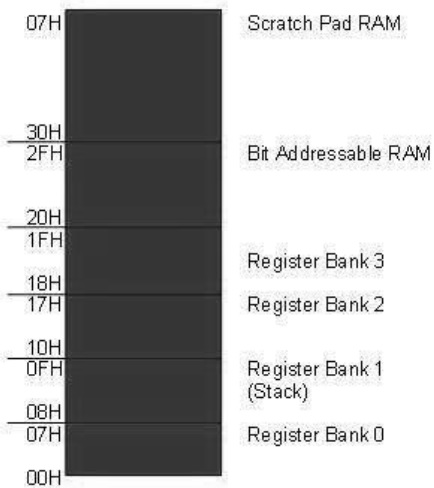
- ES - Home
- ES - Overview
- ES - Processors
- ES - Architectures
- ES - Tools and Peripherals
- ES - 8051 Microcontroller
- ES - I/O Programming
- ES - Terms
- ES - Assembly Language
- ES - Registers
- ES - Registers Bank/Stack
- ES - Instructions
- ES - Addressing Modes
- ES - Special Function Registers
- ES - Timer/Counter
- ES - Interrupts
Embedded Systems - Registers Bank/Stack
The 8051 microcontroller has a total of 128 bytes of RAM. We will discuss about the allocation of these 128 bytes of RAM and examine their usage as stack and register.
RAM Memory Space Allocation in 8051
The 128 bytes of RAM inside the 8051 are assigned the address 00 to 7FH. They can be accessed directly as memory locations and are divided into three different groups as follows −
32 bytes from 00H to 1FH locations are set aside for register banks and the stack.
16 bytes from 20H to 2FH locations are set aside for bit-addressable read/write memory.
80 bytes from 30H to 7FH locations are used for read and write storage; it is called as scratch pad. These 80 locations RAM are widely used for the purpose of storing data and parameters by 8051 programmers.

Register Banks in 8051
A total of 32 bytes of RAM are set aside for the register banks and the stack. These 32 bytes are divided into four register banks in which each bank has 8 registers, R0R7. RAM locations from 0 to 7 are set aside for bank 0 of R0R7 where R0 is RAM location 0, R1 is RAM location 1, R2 is location 2, and so on, until the memory location 7, which belongs to R7 of bank 0.
The second bank of registers R0R7 starts at RAM location 08 and goes to locations OFH. The third bank of R0R7 starts at memory location 10H and goes to location to 17H. Finally, RAM locations 18H to 1FH are set aside for the fourth bank of R0R7.
Default Register Bank
If RAM locations 001F are set aside for the four registers banks, which register bank of R0R7 do we have access to when the 8051 is powered up? The answer is register bank 0; that is, RAM locations from 0 to 7 are accessed with the names R0 to R7 when programming the 8051. Because it is much easier to refer these RAM locations by names such as R0 to R7, rather than by their memory locations.
How to Switch Register Banks
Register bank 0 is the default when the 8051 is powered up. We can switch to the other banks using PSW register. D4 and D3 bits of the PSW are used to select the desired register bank, since they can be accessed by the bit addressable instructions SETB and CLR. For example, "SETB PSW.3" will set PSW.3 = 1 and select the bank register 1.
| RS1 | RS2 | Bank Selected |
|---|---|---|
| 0 | 0 | Bank0 |
| 0 | 1 | Bank1 |
| 1 | 0 | Bank2 |
| 1 | 1 | Bank3 |
Stack and its Operations
Stack in the 8051
The stack is a section of a RAM used by the CPU to store information such as data or memory address on temporary basis. The CPU needs this storage area considering limited number of registers.
How Stacks are Accessed
As the stack is a section of a RAM, there are registers inside the CPU to point to it. The register used to access the stack is known as the stack pointer register. The stack pointer in the 8051 is 8-bits wide, and it can take a value of 00 to FFH. When the 8051 is initialized, the SP register contains the value 07H. This means that the RAM location 08 is the first location used for the stack. The storing operation of a CPU register in the stack is known as a PUSH, and getting the contents from the stack back into a CPU register is called a POP.
Pushing into the Stack
In the 8051, the stack pointer (SP) points to the last used location of the stack. When data is pushed onto the stack, the stack pointer (SP) is incremented by 1. When PUSH is executed, the contents of the register are saved on the stack and SP is incremented by 1. To push the registers onto the stack, we must use their RAM addresses. For example, the instruction "PUSH 1" pushes register R1 onto the stack.
Popping from the Stack
Popping the contents of the stack back into a given register is the opposite to the process of pushing. With every pop operation, the top byte of the stack is copied to the register specified by the instruction and the stack pointer is decremented once.